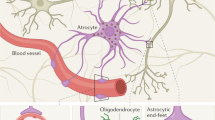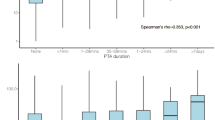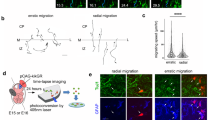Abstract
The effects of cerebral ischemia on white matter changes in ovine fetuses were examined after exposure to bilateral carotid artery occlusion. Fetal sheep were exposed to 30 min of ischemia followed by 48 (I/R-48, n = 8) or 72 (I/R-72, n = 10) h of reperfusion or control sham treatment (control, n = 4). Serial coronal sections stained with Luxol fast blue/hematoxylin and eosin were scored for white matter, cerebral cortical, and hippocampal lesions. All areas received graded pathologic scores of 0 to 5, reflecting the degree of injury where 0 = 0%, 1 = 1% to 25%, 2 = 26% to 50%, 3 = 51% to 75%, 4 = 76% to 95%, and 5 = 96% to 100% of the area damaged. Dual-label immunofluorescence using antibodies against glial fibrillary acidic protein (GFAP) and myelin basic protein (MBP) were used to characterize white matter lesions. Basic fibroblast growth factor (FGF-2) was measured in the frontal cortex by ELISA. Results of the pathologic scores showed that the white matter of the I/R-72 (2.74 ± 0.53, mean ± SEM) was more (p < 0.05) damaged when compared with the control (0.80 ± 0.33) group. Cortical lesions were greater (p < 0.05) in the I/R-48 (2.12 ± 0.35) than the control (0.93 ± 0.09) group. White matter lesions were characterized by reactive GFAP-positive astrocytes and a loss of MBP in oligodendrocytes. The ratio of MBP to GFAP decreased (p < 0.05) as a function of ischemia, indicative of a proportionally greater loss of MBP than GFAP. FGF-2 concentrations were higher (p < 0.05) in the I/R-72 than the control group and there was a direct correlation between the pathologic scores (PS) and FGF-2 concentrations (FGF-2 = e(1.6 PS-0.90) + 743, n = 17, r = 0.73, p < 0.001). We conclude that carotid artery occlusion results in quantifiable white matter lesions that are associated with a loss of MBP from myelin, and that FGF-2, a purported mediator of recovery from brain injury in adult subjects, increases in concentration in proportion to the severity of brain damage in the fetus.
Similar content being viewed by others
Log in or create a free account to read this content
Gain free access to this article, as well as selected content from this journal and more on nature.com
or
Abbreviations
- FGF-2:
-
basic fibroblastic growth factor
- EcoG:
-
electrocorticogram
- I/R-48:
-
ischemia and 48 h of reperfusion
- I/R-72:
-
ischemia and 72 h of reperfusion
- GFAP:
-
glial fibrillary acidic protein
- MBP:
-
myelin basic protein
References
Volpe JJ 1976 Perinatal hypoxic-ischemic brain injury. Pediatr Clin North Am 23: 383–397
Vannucci RC 1990 Current potentially new management strategies for perinatal hypoxic-ischemic encephalopathy. Pediatrics 85: 961–968
Vannucci RC 1993 Mechanisms of perinatal hypoxic-ischemic brain damage. Semin Perinatol 17: 330–337
Marcoux FW, Morawetz RB, Crowell RM, DeGirolami U, Halsey JH 1982 Differential regional vulnerability in transient focal cerebral ischemia. Stroke 13: 339–346
Sheldon RA, Chuai J, Ferriero DM 1996 A rat model for hypoxic-ischemic brain damage in very premature infants. Biol Neonate 69: 327–341
Jelinski SE, Yager JY, Juurlink BH 1999 Preferential injury of oligodendroblasts by a short hypoxic-ischemic insult. Brain Res 815: 150–153
Uehara H, Yoshioka H, Kawase S, Nagai H, Ohmae T, Hasegawa K, Sawada T 1999 A new model of white matter injury in neonatal rats with bilateral carotid artery occlusion. Brain Res 837: 213–220
Pantoni L, Garcia JH, Gutierrez JA 1996 Cerebral white matter is highly vulnerable to ischemia. Stroke 27: 1641–1646
Penning DH, Grafe MR, Hammond R, Matsuda Y, Patrick J, Richardson B 1994 Neuropathology of the near-term midgestation ovine fetal brain after sustained in utero hypoxemia. Am J Obstet Gynecol 170: 1425–1432
Matsuda T, Okuyama K, Cho K, Hoshi N, Matsumoto Y, Kobayashi Y, Fujimoto S 1999 Induction of antenatal periventricular leukomalacia by hemorrhagic hypotension in the chronically instrumented fetal sheep. Am J Obstet Gynecol 181: 725–730
Guan J, Bennet L, George S, Wu D, Waldvogel HJ, Gluckman PD, Faull RL, Crosier PS, Gunn AJ 2001 Insulin-like growth factor-1 reduces postischemic white matter injury in fetal sheep. J Cereb Blood Flow Metab 21: 493–502
Reddy K, Mallard C, Guan J, Marks K, Bennet L, Gunning M, Gunn A, Gluckman P, Williams C 1998 Maturational change in the cortical response to hypoperfusion injury in the fetal sheep. Pediatr Res 43: 674–682
Marumo G, Kozuma S, Ohyu J, Hamai Y, Machida Y, Kobayashi K, Ryo E, Unno N, Fujii T, Baba K, Okai T, Takashima S, Taketani Y 2001 Generation of periventricular leukomalacia by repeated umbilical cord occlusion in near-term fetal sheep its possible pathogenetical mechanisms. Biol Neonate 79: 39–45
Clapp JF, Peress NS, Wesley M, Mann LI 1988 Brain damage after intermittent partial cord occlusion in the chronically instrumented fetal lamb. Am J Obstet Gynecol 159: 504–509
Ikeda T, Murata Y, Quilligan EJ, Choi BH, Parer JT, Doi S, Park SD 1998 Physiologic histologic changes in near-term fetal lambs exposed to asphyxia by partial umbilical cord occlusion. Am J Obstet Gynecol 178: 24–32
Ohyu J, Marumo G, Ozawa H, Takashima S, Nakajima K, Kohsaka S, Hamai Y, Machida Y, Kobayashi K, Ryo E, Baba K, Kozuma S, Okai T, Taketani Y 1999 Early axonal glial pathology in fetal sheep brains with leukomalacia induced by repeated umbilical cord occlusion. Brain Dev 21: 248–252
Mallard EC, Williams CE, Gunn AJ, Gunning MI, Gluckman PD 1993 Frequent episodes of brief ischemia sensitize the fetal sheep brain to neuronal loss induce striatal injury. Pediatr Res 33: 61–65
Williams CE, Gunn AJ, Synek B, Gluckman PD 1990 Delayed seizures occurring with hypoxic-ischemic encephalopathy in the fetal sheep. Pediatr Res 27: 561–565
Williams CE, Gunn AJ, Mallard C, Gluckman PD 1992 Outcome after ischemia in the developing sheep brain: an electroencephalographic histological study. Ann Neurol 31: 14–21
Petito CK, Morgello S, Felix JC, Lesser ML 1990 The two patterns of reactive astrocytosis in postischemic rat brain. J Cereb Blood Flow Metab 10: 850–859
Pedraza L, Fidler L, Staugaitis SM, Colman DR 1997 The active transport of myelin basic protein into the nucleus suggests a regulatory role in myelination. Neuron 18: 579–589
Kiyota Y, Takami K, Iwane M, Shino A, Miyamoto M, Tsukuda R, Nagaoka A 1991 Increase in basic fibroblast growth factor-like immunoreactivity in rat brain after forebrain ischemia. Brain Res 545: 322–328
Takami K, Kiyota Y, Iwane M, Miyamoto M, Tsukuda R, Igarashi K, Shino A, Wanaka A, Shiosaka S, Tohyama M 1993 Upregulation of fibroblast growth factor-receptor messenger RNA expression in rat brain following transient forebrain ischemia. Exp Brain Res 97: 185–194
Speliotes EK, Caday CG, Do T, Weise J, Kowall NW, Finklestein SP 1996 Increased expression of basic fibroblast growth factor (bFGF) following focal cerebral infarction in the rat. Brain Res Mol Brain Res 39: 31–42
Iwata A, Masago A, Yamada K 1997 Expression of basic fibroblast growth factor mRNA after transient focal ischemia: comparison with expression of c-fos, c-jun, hsp 70 mRNA. J Neurotrauma 14: 201–210
Nozaki K, Finklestein SP, Beal MF 1993 Basic fibroblast growth factor protects against hypoxia-ischemia NMDA neurotoxicity in neonatal rats. J Cereb Blood Flow Metab 13: 221–228
Kirschner PB, Henshaw R, Weise J, Trubetskoy V, Finklestein S, Schulz JB, Beal MF 1995 Basic fibroblast growth factor protects against excitotoxicity chemical hypoxia in both neonatal adult rats. J Cereb Blood Flow Metab 15: 619–623
Barth A, Barth L, Morrison RS, Newell DW 1996 bFGF enhances the protective effects of MK-801 against ischemic neuronal injury in vitro. Neuroreport 7: 1461–1464
Jiang N, Finklestein SP, Do T, Caday CG, Charette M, Chopp M 1996 Delayed intravenous administration of basic fibroblast growth factor (bFGF) reduces infarct volume in a model of focal cerebral ischemia/reperfusion in the rat. J Neurol Sci 139: 173–179
Ren JM, Finklestein SP 1997 Time window of infarct reduction by intravenous basic fibroblast growth factor in focal cerebral ischemia. Eur J Pharm 327: 11–16
Bethel A, Kirsch JR, Koehler RC, Finklestein SP, Traystman RJ 1997 Intravenous basic fibroblast growth factor decreases brain injury resulting from focal ischemia in cats. Stroke 28: 609–615
Mallard EC, Williams CE, Johnston BM, Gluckman PD 1995 Neuronal damage in the developing brain following intrauterine asphyxia. Reprod Fertil Dev 7: 647–653
Jackson BT, Egdahl RH 1960 The performance of complex fetal operations in utero without amniotic fluid loss or other disturbances of fetal-maternal relationships. Surgery 48: 564–570
Stonestreet BS, Le E, Berard DJ 1993 Circulatory metabolic effects of beta-adrenergic blockade in the hyperinsulinemic ovine fetus. Am J Physiol 265: H1098–H1106
Gunn AJ, Gunn TR, de Haan HH, Williams CE, Gluckman PD 1997 Dramatic neuronal rescue with prolonged selective head cooling after ischemia in fetal lambs. J Clin Invest 99: 248–256
Brown AW, Brierley JB 1972 Anoxic-ischaemic cell change in rat brain light microscopic fine-structural observations. J Neurol Sci 16: 59–84
Faris RA, McBride A, Yang L, Affigne S, Walker C, Cha CJ 1994 Isolation, propagation, characterization of rat liver serosal mesothelial cells. Am J Pathol 145: 1432–1443
Ott RL, Longnecker M 2001 Statistical Methods and Data Analysis. Duxbury, Pacific Grove, CA, pp 1025–1045
Institute SASP 1990 SAS/STAT User's Guide. SAS Institute, Cary, NC, pp 891–997
Vannucci RC, Perlman JM 1997 Interventions for perinatal hypoxic-ischemic encephalopathy. Pediatrics 100: 1004–1014
Hill A, Volpe JJ 1981 Seizures, hypoxic-ischemic brain injury, intraventricular hemorrhage in the newborn. Ann Neurol 10: 109–121
Shields JR, Schifrin BS 1988 Perinatal antecedents of cerebral palsy. Obstet Gynecol 71: 899–905
Volpe J 1995 Hypoxic-ischemic encephalopathy. In: Neurology of the Newborn. WB Saunders, Philadelphia, PA, pp 260–313
Banker BQ, Larroche JC 1962 Periventricular leukomalacia of infancy. Arch Neurol 7: 386–410
Kinney HC, Back SA 1998 Human oligodendroglial development: relationship to periventricular leukomalacia. Semin Pediatr Neurol 5: 180–189
Back SA, Luo NL, Borenstein NS, Levine JM, Volpe JJ, Kinney HC 2001 Late oligodendrocyte progenitors coincide with the developmental window of vulnerability for human perinatal white matter injury. J Neurosci 21: 1302–1312
Volpe JJ 1992 Brain injury in the premature infant—current concepts of pathogenesis prevention. Biol Neonate 62: 231–242
Rice JE, Vannucci RC, Brierley JB 1981 The influence of immaturity on hypoxic-ischemic brain damage in the rat. Ann Neurol 9: 131–141
Oka A, Belliveau MJ, Rosenberg PA, Volpe JJ 1993 Vulnerability of oligodendroglia to glutamate: pharmacology, mechanisms, prevention. J Neurosci 13: 1441–1453
Mandai K, Matsumoto M, Kitagawa K, Matsushita K, Ohtsuki T, Mabuchi T, Colman DR, Kamada T, Yanagihara T 1997 Ischemic damage subsequent proliferation of oligodendrocytes in focal cerebral ischemia. Neuroscience 77: 849–861
Shuman SL, Bresnahan JC, Beattie MS 1997 Apoptosis of microglia oligodendrocytes after spinal cord contusion in rats. J Neurosci Res 50: 798–808
Ye P, D'Ercole AJ 1999 Insulin-like growth factor I protects oligodendrocytes from tumor necrosis factor-alpha-induced injury. Endocrinology 140: 3063–3072
Gard AL, Pfeiffer SE 1993 Glial cell mitogens bFGF PDGF differentially regulate development of O4+GalC− oligodendrocyte progenitors. Dev Biol 159: 618–630
Author information
Authors and Affiliations
Corresponding author
Additional information
Supported by the National Institute of Child Health and Human Development Grant R01-HD-34618.
Rights and permissions
About this article
Cite this article
Petersson, K., Pinar, H., Stopa, E. et al. White Matter Injury after Cerebral Ischemia in Ovine Fetuses. Pediatr Res 51, 768–776 (2002). https://doi.org/10.1203/00006450-200206000-00019
Received:
Accepted:
Issue date:
DOI: https://doi.org/10.1203/00006450-200206000-00019
This article is cited by
-
Inflammatory responses in hypoxic ischemic encephalopathy
Acta Pharmacologica Sinica (2013)



